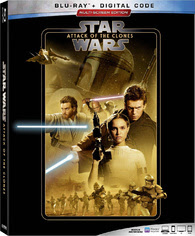Blu-ray Review: 'Star Wars: Attack of the Clones' (2019 Buena Vista Home Entertainment Reissue)

The new slipcover (and jewel box) art for the Multi-Screen Edition of Star Wars: Attack of the Clones. © 2019 Buena Vista Home Entertainment and Lucasfilm Ltd. (LFL) On September 22, Buena Vista Home Entertainment and Lucasfilm Ltd. reissued the 10 existing Star Wars live-action films in Multi-Screen Editions in Blu-ray and DVD along with codes for digital versions for streaming on Movies Anywhere and other Disney partners. Dubbed the "Multi-Screen Edition," this re-release came three months in advance of the theatrical premiere of the last Skywalker Saga film, Star Wars - Episode IX: The Rise of Skywalker, which opens on December 20. This promotional photo shows nine of the 10 titles in the Multi-Screen Edition collection of Blu-ray/Digital Code sets released by Buena Vista Home Entertainment and Lucasfilm on September 22. © 2019 Buena Vista Home Entertainment and Lucasfilm Ltd. (LFL) Although Buena Vista and Lucasfilm (both wholly-owned subsidiaries of The Walt...






